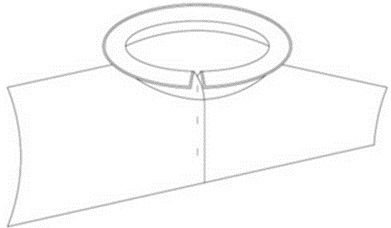Industrial property rights offer a wide range of possibilities to protect product innovations (or only parts thereof) against imitations through registration. The various IP rights are subject to different requirements. For example, a trademark registration requires that an applied-for sign or shape is suitable to indicate a certain business origin. A design, on the other hand, must among other things be new at the time of application. That choosing the “correct” IP right requires careful consideration and that reaching for the wrong shelf can have unintended consequences is illustrated by a case that was recently decided before the Federal Patent Court (BPatG).
A fashion designer had filed an application with the German Patent and Trade Mark Office (DPMA) for the design of an original collar as a three-dimensional trademark for, inter alia, clothing. One of the illustrations submitted for this purpose looked as follows:

(cf. https://register.dpma.de/DPMAregister/marke/fullimage/5457374$002cDE$002c3020182132441/-1)
It was a collar consisting of a stand-up collar and a circular ring segment applied transversely thereto. The DPMA refused the trademark application for lack of distinctive character. In its reasoning, the authority stated that a product design may be indicative of origin and thus capable of being trade-marked. However, a prerequisite for this was that the design deviated significantly from the existing variety of designs. This was not the case here, especially as the collar merely fitted into the usual range of shapes of the existing collar variants.
The fashion designer filed an appeal against this and pointed out that the claimed collar shape as a “flying collar” clearly deviated fromusual collars. The public was also accustomed to collar shapes as operational indications of origin, as shown, for example, by the “Armani” collar.
The BPatG has now dismissed the fashion designer’s appeal (resolution of 14.09.2022, 29 W (pat) 531/21). The court correctly pointed out that – as with every type of trademark – it must also be examined in the case of three-dimensional trademarks whether the public recognises an indication of origin in the trademark. The court answered this in the negative for the collar, which, in the opinion of the senate, was within the scope of customary variations in shape. Nor had the familiarity of an “Armani” collar, which could lead to a certain customary use in favour of references to origin through collar shapes, been proven.
What is interesting about the decision is the fact that the court even concedes that the applicant has developed a novel and possibly also original design. Those are the prerequisites that speak for the protectability of the collar as a design. In trademark law, however, any novelty is irrelevant, especially since the only decisive factor is whether the design applied for as a trademark can serve as an indication of origin.
Of course, one can only speculate why the designer decided to apply for a trademark rather than a design. In any case, a design application would have been the better choice because it would have been more promising. Especially since, as the decision shows, the designer had already faced the adoption of the collar by other fashion labels. She had presented the collar to them, presumably assuming that she was protected by the trademark application.
